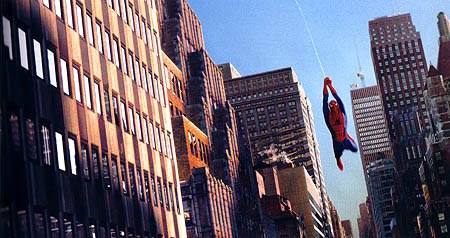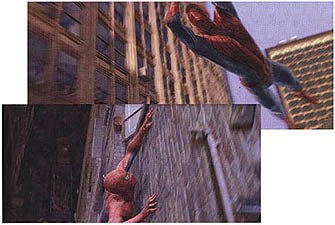Rick DeMott swings in on Sony Pictures Imageworks to find out how they created visual effects amazing enough to match Spider-Man.

Sony Pictures Imageworks rose to the dual challenge of creating a swinging Spider-Man travelling through a virtual New York. All images unless otherwise noted are © 2002 Columbia Pictures Industries, Inc. All rights reserved.
"Spider-Man -- Spider-Man -- doing whatever a spider can."
In regards to the approach the effects team took on the new live-action blockbuster Spider-Man, the old theme song surely rings true. The folks at Sony Pictures Imageworks were given the daunting task of making a man swing through gulches of city buildings, crawl up vertical walls, dodge super-charged throwing stars, along with various other feats of wonder, in nearly 500 effects shots. To add to the mix, it had to look as real as possible. Superhero flicks of yesteryear have been set in fictional surroundings -- Spider-Man was set in the very familiar movie location of New York City. I talked to the film's animation director Anthony LaMolinara and visual effects supervisor Scott Stokdyk to find out the process in which the effects team approached bringing the man in red and blue to the big screen.

Spider-Man's animation director Anthony LaMolinara (left) and visual effects supervisor Scott Stokdyk were key to the film's animated visual effects. © Sony Pictures Imageworks.
Re-Creating Reality
One of the toughest challenges was the creation of the virtual New York City setting. To achieve the appearance of Spider-Man swinging from building to building, moving away from the camera and toward it, the filmmakers were forced to create the landscape in the computer due to the impossibility of shooting the sweeping camera movements in real life. To get the look of the city as perfect as possible, the effects and production design team started off by surveying both Times Square and the Queensboro Bridge to gain accurate geometry and texture details. LaMolinara described part of the process of creating the cityscape as a pan and tile procedure. Approximately 25 images (or tiles) of the background environment were taken along a 180-degree axis and then were stitched together to create a half sphere for the action to move through. Afterward, other buildings were placed in the foreground and rendered as complete 3D objects. If you're asking yourself why this is interesting and why it's significant I'll tell you.
To create a complete city of 3D buildings would have taken an enormous amount of computer space and time. This tile and pan process saved time and memory space by limiting the amount of complete 3D items. The reason the flat background works is because of the way one's eye registers perspective. When the camera moves past objects the perspective changes greatly when things are closer. However, the perspective of objects in the far background would stay relatively the same -- thus the flat image is unnoticeable when moving through the foreground space.
 The tile and pan procedure was used to create the cityscape. First, a motion-control film camera shot the desired visuals. It was programmed to capture predetermined pan and tilt angles. Each angle, a.k.a., a tile, was scanned into the computer, creating a mosaic Stokdyk calls "a virtual geodesic dome." Next, the tiles were seamed together to create a continuous environment with borders. Then the borders were taken out. Lastly, with color correction, the image looks flawless and realistic.
The tile and pan procedure was used to create the cityscape. First, a motion-control film camera shot the desired visuals. It was programmed to capture predetermined pan and tilt angles. Each angle, a.k.a., a tile, was scanned into the computer, creating a mosaic Stokdyk calls "a virtual geodesic dome." Next, the tiles were seamed together to create a continuous environment with borders. Then the borders were taken out. Lastly, with color correction, the image looks flawless and realistic.
Now that we understand more about how the settings were created we can look into how our hero was incorporated into them. The first step of creating the digital representation of Spider-Man had star Tobey Maguire and his stunt double's bodies scanned into the computer to create duplicate models. To create the movement of the character, LaMolinara and Stokdyk said the animators watched both Tobey and the stuntman's movements. The video references of the actors were then used to sculpt the character's entire motion range down to muscle twitches and flexes. The effects crew even worked closely with the costume design team to create the silk-screen and sub-textures of the Spider-Man suit.
Bringing Myth to Life
At first acrobats from Cirque du Soleil were brought in as movement references. However, director Sam Raimi wanted to stress the inhuman quality of Spider-Man's superhuman abilities. Inspiration came from many sources including cats, insects and even another animated hero -- Disney's Tarzan. Because so much of the swinging, jumping and crawling were up to the animators' imaginations, it came down to extensive trial and error testing to get the movement just right. For example, in one scene, Spider-Man swings from underneath a bridge to land on top of it. LaMolinara said the original landing was much harder, but Raimi commented that a spider would have landed much softer.
It's this collaborative work ethic that ran through the whole creation process. LaMolinara explains, "Sam gave us general ideas, but left a lot open for us as artists to experiment. Sam is very democratic. Why restrict ideas by telling someone exactly what you want?" The trial and error started out with creating simple rectangle shaped buildings based on the storyboards. Special effects supervisor John Dykstra helped the animators place the camera in the right locations for emphasizing character development and emotion. With the growing use of camera movements being made within the computer, LaMolinara feels there should be a credit for digital cinematography.

replace_caption_demottsm08.jpg
Another aspect of the animation was to bring out the progression of Spider-Man's developing skills. Both LaMolinara and Stokdyk stressed that this was the most enjoyable part of the process because it was the first time they had the opportunity in a live-action effects film to develop a character arch through their animation. When Spider-Man first starts swinging from building to building, his movement is very erratic and herky-jerky, but by the end of the film his swinging is graceful. The animators did many physical tests to see what the force of swinging from elastic webs would be on the body. In addition, they mapped out the effects of various types of webs from thin ones to strong ones to very springy ones. Just to get an idea of the amount of time it took to nail the effects, the final web swing at the end of the film took 7 months to lock down the character and camera movements.
Besides making the action look natural, the effects crew focused on every minute detail. One of the difficult scenes to create was the first scene when Spider-Man swings through the city. Because he's wearing his makeshift suit, the effects team not only had to determine the motion's effects on the character's body, but also on his loose-fitting clothes. Some of the detailing, however, did allow the animators to have some fun. In the burning building scene Spidey's webs wrinkle and burn like real webs in a flame, while in the Times Square scene, great attention was made to the feel and effect of landing on large hot air balloons.

There was a lot of trial and error before Spider-Man's movements were perfected. The animators were inspired by felines, insects and Tarzan.
I did confess to LaMolinara and Stokdyk that the virtual New York fooled me, but that I could tell that Spider-Man was digital. Stokdyk made two comments regarding his digital character. Firstly, the filmmakers did take some liberties with lighting, which could have led to an unreal look. This was done for two reasons. First reason was to highlight the character in the frame for dramatic reasons and secondly the animators discovered that when lighting was added to the initial character movement it made the action seem speeded up. Second is the fact that he moves like a spider more than a human. Seeing a human move that way is unnatural. Stokdyk said if you saw a guy in red and blue tights swinging between buildings at 80 mph, you wouldn't believe it was real either!

Details like the burning of Spider-Man's webs in this scene helped add credibility to the action.
LaMolinara is already excited about working on the sequel, which he said could feature such villains as Dr. Octopus and the Lizard. However what he's most interested in is "exploring Spider-Man's movements without the webs." With the first film's enormous box-office bankroll, I'm sure over the upcoming years, both LaMolinara, Stokdyk and the rest of the SPI crew will have many more chances to experiment with your friendly neighborhood web-slinger.
Go even further behind the visual effects scenes of Spider-Man with the following book:
Behind the Mask of Spider-Man: The Secrets of the Movie by Mark Cotta Vaz. New York, NY: A Del Rey Book, published by The Ballantine Publishing Group, a division of Random House, 2002. 205 pages. ISBN: 0-345-45004-3.
Rick DeMott is a freelance journalist working in Los Angeles. He is also a regular contributor to the humor website, PorkPony.com.







